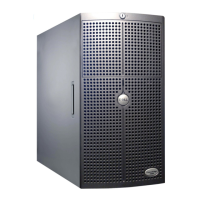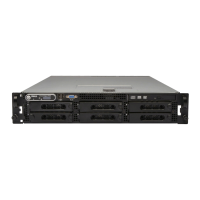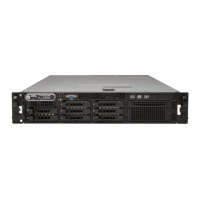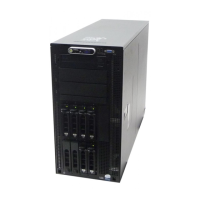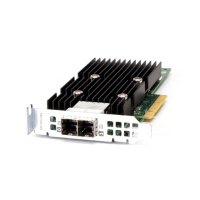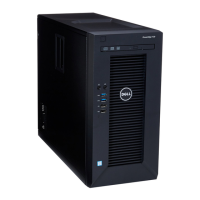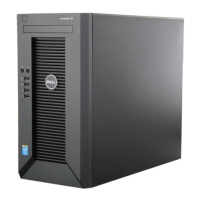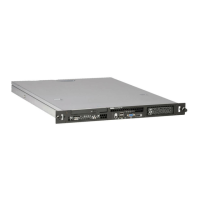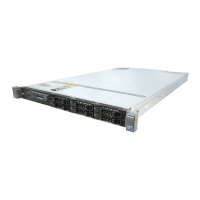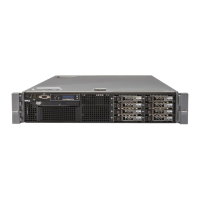CPU Information Screen
Table3-3 lists the options and descriptions for the information fields that appear on the CPU Information screen.
Table 3-3. CPU Information Screen
Integrated Devices Screen
Table3-4 lists the options and descriptions for the information fields that appear on the Integrated Devices screen.
Table 3-4.IntegratedDevicesScreenOptions
Displays a screen to configure the system password and setup password features. See "Using the System Password" and "Using the Setup
Password" for more information.
Keyboard
NumLock
(On default)
Determines whether your system starts up with the NumLock mode activated on 101- or 102-key keyboards (does not apply to 84-key
keyboards).
Report
Keyboard
Errors
(Report
default)
Enables or disables reporting of keyboard errors during the POST. Select Report for host systems that have keyboards attached. Select Do
Not Report to suppress all error messages relating to the keyboard or keyboard controller during POST. This setting does not affect the
operation of the keyboard itself if a keyboard is attached to the system.
Displays the customer-programmable asset tag number for the system if an asset tag number has been assigned. To enter an asset tag
numberofupto10charactersintoNVRAM,see"Assigning or Deleting an Asset Tag Number."
Displays the bus speed of the processors.
Displays when the processors support HyperThreading. Enabled permits all logical processors to be used by the operating system. Only
the first logical processor of each processor installed in the system is used by the operating system if Disabled is selected.
Sequential
Memory Access
(Enabled default)
Displays when the processor supports sequential memory access. Enabled optimizes the system for applications that require sequential
memory access. Disabled is used for applications with random memory access.
Displays the family and model number of each processor.
Displays the clock speed of the processor(s).
Displays the amount of cache memory for the processor.
Primary SCSI
Controller
(SCSI default)
Enables the integrated SCSI subsystem. This field displays only when RAID is not detected in the system. Off disables the SCSI
subsystem.
Channel A and Channel B operate independently.
Selects between RAID Enabled, SCSI Enabled, or Off. The configurable options vary, depending on whether the optional ROMB key
and memory are installed.
l With the ROMB key and memory module installed — Select either RAID Enabled or Off.
l Without the ROMB key and memory module installed — Select either SCSI Enabled or Off.
Channel A and Channel B operate independently. If the Channel A displays RAID Enabled, Channel B can be set to RAID Enabled,
SCSI Enabled, or Off.
IDE CD-ROM
Controller
(Auto default)
Enables the integrated IDE controller. When set to Auto, each channel of the integrated IDE controller is enabled if IDE devices are
attached to the channel and the external IDE controller is not detected.
Enables or disables the system's diskette drive controller. When Auto is selected, the system turns off the controller when necessary to
accommodate a controller card installed in an expansion slot. You can also configure the drive as read-only. When using the read-only
setting, the drive cannot be used to write to a disk.
USB Controller
(On with BIOS
support default)
Enables or disables the system's USB ports. Options are On with BIOS support, On without BIOS support, or Off. Disabling the USB
ports makes system resources available for other devices.
Embedded Gb
NIC1
(Enabled with PXE
default)
Enables or disables the system's integrated NIC. Options are Enabled without PXE, Enabled with PXE, and Disabled. PXE support
allows the system to boot from the network. Changes take effect after the system reboots.
Displays the MAC address for the integrated 10/100/1000 NIC. This field does not have user-selectable settings.
Embedded Gb
NIC2
(Enabled with PXE
default)
Enables or disables the system's integrated NIC. Options are Enabled without PXE, Enabled with PXE, and Disabled. PXE support
allows the system to boot from the network. Changes take effect after the system reboots.
Displays the MAC address for the integrated 10/100/1000 NIC. This field does not have user-selectable settings.
Serial Port 1
(COM1 default)
Serial Port 1 options are COM1, COM3, BMC Serial, BMC NIC, and Off. If an optional remote access controller (RAC) is installed in the
system, RAC is an additional option.

